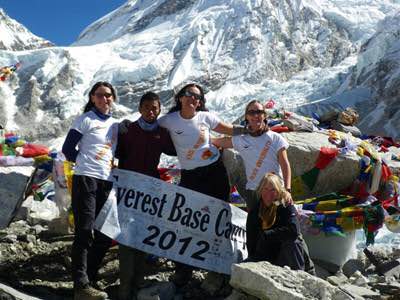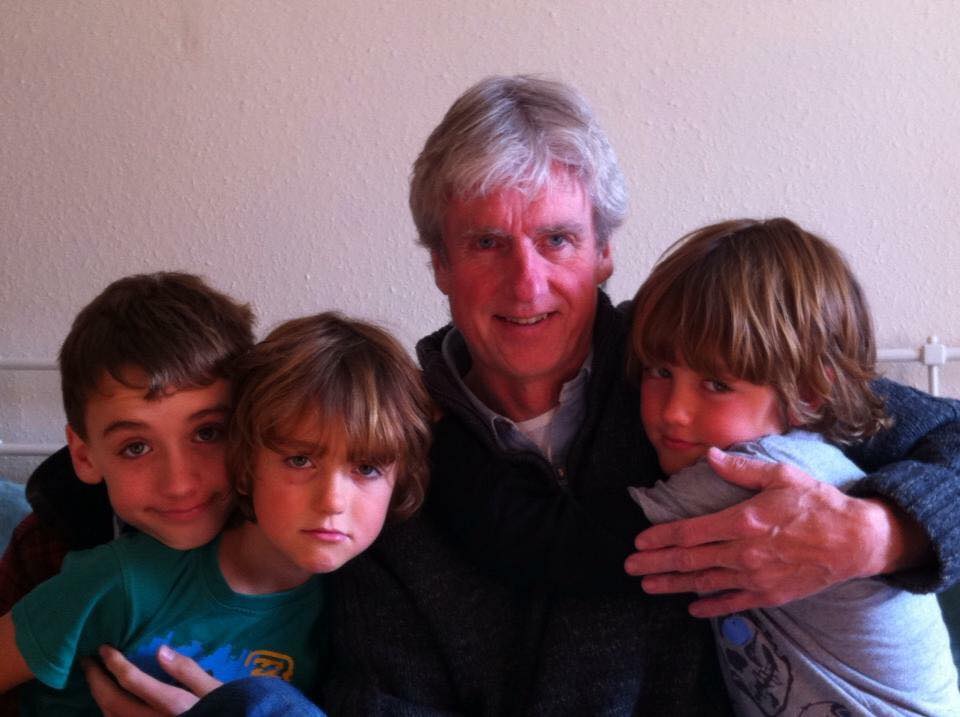Što je Novog
5Rhythms Tribe | Dancing through Death & Life
October 5, 2016
In 2012, 2 days after Gabrielle Roth passed away, 5Rhythms teacher and UK ambassador for Women for Women International Neda Nenadic walked to Everest Base Camp to raise money for women survivors of war, dancing along the way. 4 years later, she was with her husband in his last days, facing his death. This is her reflection on life, death, grief, and gratitude and dancing it all, as told to Morgan Nichols on 21st September 2016.

You cannot have the deep love of life if you’re going to avoid the suffering – this is the teaching of the practice – Neda Nenadic
Since I was 17, it was my dream to visit Mount Everest. I had been supporting Women For Women International for years. WFWI was started after the war in Bosnia, which felt close to the history of my own country, Croatia. They offered me half the fees to take up a place on the team doing this walk. I was so honoured and I took it on.
It was a year since we had finished our teacher training, and we were the last teachers training with Gabrielle Roth. It was only then, after 22 years of practicing this work, and after her death, that I realised just how much I respected Gabrielle; that I realised what she meant to me in this life. It was such a beautiful journey of grief and gratitude. On the walk, we were honouring not only the fund-raising for WFWI, but recognising that each woman and each human being has to walk their own inner and outer mountains. I see it on the dancefloor all the time. The magnitude of those mountains reduces you to the humility of one breath and one step. You cannot take this journey with your ego – it’s a journey of surrender.
I just shiver now, when I think about the dancing along the way, the crying along the way. The immensity of grief and gratitude for Gabrielle. We made prayer flags in our community and carried them up to the mountain. At every stupa* we came to, I showed Gabrielle’s picture to it and honoured it.
One night, we were walking in this beautiful village at 3440 metres above the sea level, moon shining, mountain crystal clear, quiet and serene, and I had a monologue with myself: “God, Gabrielle, you are my teacher, and I wonder a lot about spirit. Where are you, what has happened? What on earth is this body and this soul? Does anything else exist?” As I walked down the steps in this quiet little village, suddenly I heard “Smells like Teen Spirit”, one of Gabrielle’s favourite songs. I went to the bar and asked the guys there to put the song on again so I could dance to it. Then I asked one of the Australian guys to film me. It was so hard to dance on that altitude to that song because you really can’t move properly. I gave everything of myself.
We arrived at Everest base camp, at the glacier. Mount Everest is called “Chomolungma” in Tibetan, translated as “Mother of the universe”. We put out the prayer flags out and I said, “I’m just going to see if I can move and dance.” That was my offering. I had a wish to dance to the song, “Wise enough” by the band Lamb. Nothing was choreographed, I had matty hair, I had my period and I hadn’t showered for days. But I thought, “My God, I have got this far. I promised myself I would do this for these women and for Gabrielle.” At one point, I thought I was going to faint – this was where you see me lie down in the video. It still is one of my favourite dances because it was a total surrender! I was going to delete the video, but then I thought, at that time that was my heart and soul’s offering, something I’ve lived. It was a really profound journey, inwards and outwards.
The morning after we came down from the mountains, two men came to sit with me at breakfast. They were wearing robes – everyone’s in robes in Katmandu. They told me they were monks. I joked with one of them and said, “Are you one of those people who are reincarnated as a lama and remember everything from your previous life, even as a child?” and he said “Yes”. He was a Shamarpa, the holder of the lineage of the Karma Kagyu school of Tibetan Buddhism. I told him that I knew that in his tradition they have very special prayers for those who have died, and I said that my teacher had died. I showed him Gabrielle’s picture and asked if they could pray for her. The lama recognised her, and it turned out that he had seen her in New York. Chogyam Trungpa was his teacher, and Gabrielle really loved him so she must have gone to one of his talks.
What I have learned in this dance is phenomenal; how it serves me in my life. It has a cyclical fullness. So, as we grow old and we have more experiences with relationships and life, there is always an opportunity to open the heart and the mind a little bit more and to soulfully expand to receive the fullness of life. This dance gives us a chance to practice our soul muscle, extending to embrace the joy, suffering, love and passion for life. We are not choosing one or the other in this rich life. I’m not looking to run away from anything.
I really feel relentless in the dance. It totally plugs me into the life force, the universe, the whole of existence. I look at how the universe keeps changing: transforming and moving, churning and shifting, all the time with that centredness inside it. It never loses its original way of unfolding although it doesn’t know where it’s going. It’s an absolutely phenomenal practice.
There is a place in me that I come to when I dance: that begging place in myself. It’s way beyond positive thinking or prayer, that surrender which is absolute and total. I think that’s what I love: the depth of myself that is revealed, and I am not satisfied until I hit that point because only from that depth can I drink life. This summer, Kate Shela came to teach in Brighton, and she really brought me to that place of begging to have the core of myself back. She was a true MOT for my soul! I deeply appreciate her and her teaching.
I am learning that the dance will take all of my rage, disappointment, anger, grief, stress, confusion – what I am learning is that the world needs my kindness and love. This is where I go to tune myself into my own humanity. I take everything to the practice that I need to. Because the living or the dying person needs our centred heart and our courage to be true. There is such tenderness in that fierceness. The dance tells me: bring me all of your struggles and you’ll find medicine in this.
I say to my students, “Gabrielle always said ‘This is it, this is spiritual work.’” For me, practice, off or on the dancefloor, never stops. The deepest level of the practice is here in my home and my family. Now, nearly four years after the trek, my husband and dear friend Martin, with whom I have a very complex relationship, is dying. Right now, not knowing how things will unfold, I have to dare to trust in each moment to do what needs to be done. There is a lot of story between Martin and me, but in the 5 Rhythms Mirrors map, I am looking at myself. So I keep asking myself: can I embrace this frail, dying and decaying body and still practice opening to love? Can I breathe through the layers of the story between us and keep opening to tenderness and connection? And can I stay with this human being, trusting as the layers of the story keep on shedding?
That stillness, when everything has been said, everything has been danced; there is just this bare presence of a human being. To be in the presence of death is to be in the presence of a great teacher. It absolutely blows my mind. The mystery doesn’t want to be resolved or solved – it just keeps deepening its wonder. It’s something to just be honoured. Gabrielle said: this union of the spirit and the flesh, is the most beautiful love story that goes on inside us. And the separation of them, the breath from the body, is heartbreaking and beautiful. As a human being and a teacher, the question gets deeper for me: who are we, who is breathing who? That’s what Gabrielle kept saying. And what is this body without the spirit and the breath?
This discipline of seeking emptiness allows us to fully embrace life and to be available as authentic, grounded heart centred human beings to others. You’re not holding grudges from 20 years ago; you can clear it out and serve in whatever way is needed.
*Stupa – a mound-like or hemispherical structure containing relics and used as a place of meditation.
On the 24th of September 2016, Martin Thorpe died at home, surrounded by Neda and their 3 sons, James, Sam and Luka.

Neda: “How do you treat the body of your loved one once they die? How do you end 62 years of life and say goodbye? We as a family with our dear friends gave ourselves time to be with Martin’s body a bit longer and kept him at home for a week after he died, offering our prayers and honouring the body in which his spirit lived. My dear friend Stephen Jenkinson (http://orphanwisdom.com/) said, “When you love a flower, how much of the flower do you love?” There is tenderness in grief that, like a ladle, scoops the depth of our hearts so that the gratitude, humility, love and grace of life can pour itself back in. There is a razor sharp truth that life speaks loudly in the silence to us if we are willing to sit with the dead body. There is a voice of mystery that speaks on this threshold about our own ending of days. Inviting us to live and love with courage. To let it all move through us, embracing it all, dancing it all. … This heartbreakingly beautiful life.”
Women for Women International UK provides women survivors of war, civil strife and other conflicts with the tools and resources to move from crisis and poverty to stability and self-sufficiency, thereby promoting viable civil societies. Their aim is to build communities of supporters and to change the world one woman at a time. Neda has been sponsoring 5 women through education every year for the last few years, www.womenforwomen.org.uk/
< BACK TO NEWS
Prijava za newsletter i e-poštu
Želite li od nas primati newsletter i e-poštu, molimo ispunite ovaj obrazac i pošaljite nam ga: * Obavezna Polja

